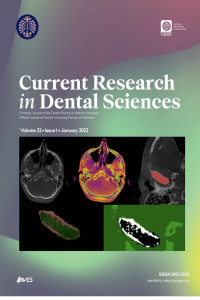ORAL CERRAHİ UYGULANAN HASTALARDA İPEK, POLYESTER [POLY (ETHYLENETEREPHTHALATE)], POLYGLYCOLIC ACID VE POLY(GLYCOLIDE-COLACTIDE) SÜTÜR MATERYALLERİNİN MİKROBİYOLOJİK AÇIDAN KARŞILAŞTIRILMASI
sütür materyalleri, mikrobiyolojik türler, oral cerrahi
MICROBIOLOGIC COMPARISON OF SILK, POLYESTER [POLY(ETHYLENETEREPHTHALATE)], POLYGLYCOLIC ACID, AND POLY(GLYCOLIDE-CO-LACTIDE) SUTURE MATERIALS IN ORAL SURGERY
Suture materials, microbiological strains, oral surgery,
___
- 1. Yu GV, Cavaliere R. Suture material, properties and uses. J Am Podiatry Assoc 1983; 73: 57–64.
- 2. Parirokh M, Asgary S, Eghbal MJ, Stowe S, Kakoei S. A scanning electron microscope study of plaque accumulation on silk and PVDF suture materials in oral mucosa. Int Endod J. 2004; 37: 776–781.
- 3. Yaltirik M, Dedeoglu K, Bilgic B, Koray M, Ersev H, Issever H, Dulger O, Soley S. Comparison of four different suture materials in soft tissues of rats. Oral Dis 2003; 9: 284-286.
- 4. Shaw RJ, Negus TW, Mellor TK. A prospective clinical evaluation of longevity of resorbable sutures in oral mucosa. Br J Oral Maxillofac Surg. 1996; 34: 252-254.
- 5. Bayer S, Demirtas N, Kazancıoglu HO. Suture materials in maxillofacial surgery: A literature review. J Dent Fac Atatürk Uni. 2015; Suppl 11; 105-113.
- 6. Selvig KA, Biagiotti GR, Leknes KN, Wikesjo UME (1998) Oral tissue reactions to suture materials. Int J Periodontics Restorative Dent. 1998; 18: 475–487.
- 7. Greenwald D, Shumway S, Albear P, Gottlieb L. Mechanical comparison of 10 suture materials before and after in vivo incubation. J Surg Res 1994; 56: 372-377.
- 8. Sortino F, Lombardo C, Sciacca A. Silk and polyglycolic acid in oral surgery: A comparative study. Oral Surg Oral Med Oral Pathol Oral Radiol Endod 2008; 105: e15-e18.
- 9. Chu CC, Williams DF. Effects of physical configuration and chemical structure of suture materials on bacterial adhesion. Am J Surg 1984; 147: 197-204.
- 10. Banche G, Roana J, Mandras N, Amasio M, Angeretti A, Tullio V, Cuffini AM. Microbial adherence on various intraoral suture materials in patients undergoing dental surgery. J Oral Maxillofac Surg 2007; 65: 1503-1507.
- 11. Grigg TR, Liewer FR, Patton WR,Buxton TB, Mcpherson JC. Effect of the wicking behaviour of multifilament sutures. J Endod 2004; 30: 649-652.
- 12. Otten JE, Wiedmann-Al-Ahmad M, Jahnke H, et al. Bacterial colonization on different suture materials-A potential risk for intraoral dentoalveolar surgery. J Biomed Mater Res B Appl Biomater 2005; 74: 627.
- 13. Giray CB. Clinical and electron microscope comparison of silk sutures and n butyl-2-cyanoacrylate in human mucosa. Aust Dent J 1997; 42: 255-258.
- 14. Lilly GE. Reaction of oral tissues to suture materials. Oral Surg Oral Med Oral Pathol 1968; 26: 128-133.
- 15. Lilly GE, Armstrong JH, Salem JE, Cutcher JL. Reaction of oral tissues to suture materials.II. Oral Surg Oral Med Oral Pathol 1968; 26: 592-599.
- 16. Durdley P, Bucknall TE. Assesment of sutures for use in colonic surgery: an experimental study. J R Soc Med 1984; 77: 472-477.
- 17. Rothenburger S, Spangler D, Bhende S, Burkley D. In vitro antimicrobial evaluation of coated Vicryl plus antibacterial suture (coated polyglactin 910 with triclosan) using zone inhibition assays. Surg Infect 2002; 3: 79-87.
- 18. Brown AR, Papasian CJ, Shultz P, Theisen FC, Shultz RE. Bacteremia and intraoral suture removal: Can an antimicrobial rinse help? J Am Dent Assoc 1998; 129: 1455-1461.
- 19. King RC, Crawford BA, Small EW. Bacteremia following intraoral suture removal. Oral Surg Oral Med Oral Pathol 1988; 65: 23-28.
- 20. Giglio JA, Rowland RW, Dalton HP, Laskin DM. Suture removal-induced bacteremia: a possible endocarditis risk. J Am Dent Assoc 1992; 123: 65-70.
- 21. Martin M. Is there a link between tooth brushing and infective endocarditis? Int Dent J 2003; 53: 187-189
- Başlangıç: 1986
- Yayıncı: Atatürk Üniversitesi
Hatice AĞAN, Ayhan GÜRBÜZ, Rukiye DURKAN, Gdnca DESTE
ZİRKONYA DENTAL İMPLANTLAR: KLİNİK PARAMETRELER, YAPISAL ÖZELLİKLER, GÜNCEL SİSTEMLER
Gonca DESTE, Rukiye DURKAN, Perihan OYAR
SONLU ELEMANLAR STRES ANALİZİ YÖNTEMİNİN İMPLANT CERRAHİSİNDE KULLANIMI
Kübra CANTÜRK, Buket KARALAR, Ömer SAĞSÖZ, Nilgün SEVEN, Nurdan POLAT SAĞSÖZ, Yusuf ZİYA BAYINDIR
M. Gülce SUBAŞI, Necla DEMİR, Muhammet KARCI, Mehtap GÖKKAYA BOZKURT
AİLELERİN FLORÜRLÜ AĞIZ BAKIM ÜRÜNLERİNE BAKIŞ AÇILARININ VE DAVRANIŞLARININ DEĞERLENDİRİLMESİ
Banu ÖTER, Barış KARABULUT, Günseli GÜVEN POLAT, Sevi Burçak ÇEHRELİ
TEMPOROMANDİBULAR EKLEM HASTALIKLARINDA MEDENİ HAL DURUMU
Muhammed Enes NARALAN, Binali ÇAKUR
ÇENELERİN BENİNG FİBROOSSEÖZ LEZYONLARININ KONİK IŞINLI BİLGİSAYARLI TOMOGRAFİ ile DEĞERLENDİRİLMESİ
